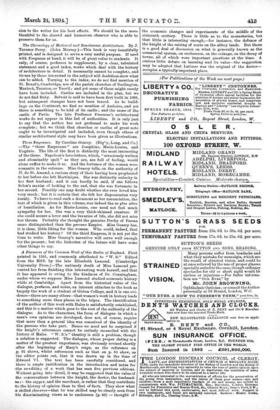A Discourse of the Common Weal of this Realm of
England. First printed in 1581, and commonly attributed to " W. S." Edited 'from the MSS. by the late Elizabeth Lamond. (Cambridge University Press.)—The untimely death of Miss Lamond pre- vented her from finishing this interesting work herself, and that it has appeared is owing to the kindness of Dr. Cunningham, under whom we suppose Miss Lamond studied economic history while at Cambridge. Apart from the historical value of the dialogue, prefaces, and notes, an interest attaches to the book as largely the work of a student of Girton College, and it is one evi- dence—there are many others—that women's work in history leads to something more than places in the tripos. The identification of the author of this work with Hales is satisfactorily established, and this is a matter which goes to the root of the authority of the ,dialogue. As to the characters, the form of dialogue in which a man's own opinions are developed, does not, of course, require that more than a general idea was conceived of the identity of the persons who take part. Hence we need not be surprised if the knight's utterances cannot be entirely reconciled with the history of Hales. " W. S.'s " identity is still a problem, though a solution is suggested. The dialogue, whose proper dating is a matter of the greatest importance, was obviously revised shortly :after the beginning of Mary's reign, as the reference on p. 91 shows, whilst references such as that on p. 85 show, as the editor points out, that it was drawn up in the time of Edward VI. The text has been carefully considered, and there is ample justification in the introduction and notes for rthe re-editing of a work that has seen five previous editions. Without going into detail, it may be suggested that the value of the conversations between the knight, the doctor, the husband- = t, the capper, and the merchant, is rather that they contribute to the history of opinion than to that of facts. They show what =a skilled observer—that he was skilled may be clearly seen from .his discriminating views as to enclosures (p. 49) — thought of the economic changes and experiments of the middle of the sixteenth century. There is little as to the monasteries, but that little is interesting enough,—for instance, the defence of the knight of the raising of rents on the abbey lands. But there is a good deal of discussion on what is generally known as the commercial system, on enclosures, on the coinage, on the decay of towns, all of which were important questions at the time. A curious little debate on learning and its value—the suggestion may be adopted that Latimer was the original of the dootor- occupies a typically important place.


































 Previous page
Previous page